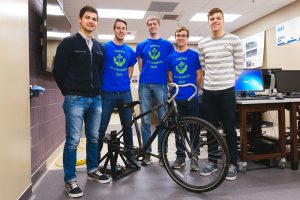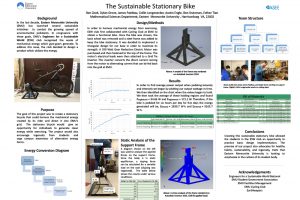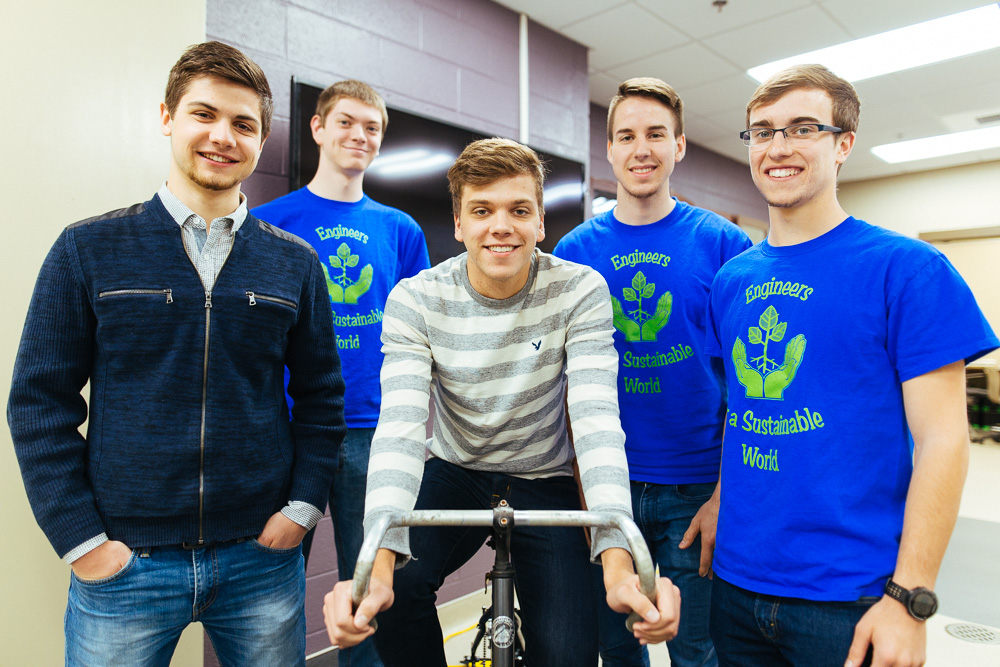A poster about a stationary bike project at Eastern Mennonite University took top honors among 61 other competitors in the first- and second-year undergraduate design team division at the American Society for Engineering Education’s (ASEE) Zone 2 Conference.
Dylan Grove and James Paetkau, engineering students and members of the Engineers for a Sustainable World (ESW) club, were the primary poster designers. They traveled to the March 2-5 conference in San Juan, Puerto Rico, with engineering faculty members Esther Tian and Daniel King.

“This ASEE conference was comprised of engineering programs at large and small universities from over 15 states, so we were quite happy to see our students receive this external validation and encouragement about the quality of their project and presentation,” said King.
The win is especially significant considering the competition included large engineering programs from University of Florida, Virginia Commonwealth University, West Michigan University, West Virginia University and Mercer University.
The chapter, which was established in 2013, has also won other accolades for their projects, says Tian, club advisor, who praised the students’ dedication to their work. “Our greenhouse project won second place at the ASEE Southeastern Section conference in 2014, and our solar-powered chicken coop project competed at the ASEE national conference in 2015. I am very pleased with the work of our students.”
Like all ESW projects, the bike and the poster were team efforts. Club members Ben Zook, Collin Longenecker, Austin Engle, Ben Stutzman and Andrew Troyer also contributed to the poster, which was designed during the fall 2016 semester.
At the poster session, Grove and Paetkau said professors and judges showed considerable interest in the project itself.
The goal of the bike was to contribute to EMU’s variety of sustainability initiatives on campus by channeling “the waste of mechanical energy generated by exercise machines,” the researchers said. “To reduce the unnecessary waste, the club saw the opportunity to add an alternative form of energy created by gym goers on campus … The stationary bicycle would serve as a way to promote sustainability and give an opportunity for individuals to generate clean energy while exercising.”

Fundings from an Earthkeepers mini-grant helped start the project, which drew on skills, time and labor of several club members, as well as welding provided by physical plant employee Henry Bowser. A 350-watt gear reduction electric motor replaced the back wheel, a chain connected pedals and motor crankshaft, and a grid tie inverter used to convert direct current to alternating current compatible with EMU’s grid.
Several attendees at the poster session suggested that storage of the energy was the next step. “More than asking us questions about the project, they gave us suggestions about what to do with the project in the future,” Grove said.
“They really pushed us to think about how we could use this project to create change,” Paetkau added.
He said being at the conference among engineers and other engineering students was worth the trip itself. “It really made me excited about what we can do in the future, especially seeing some of the junior/senior projects.”
Grove was pleased to see that EMU “stacks up” to other programs. “We’re a smaller university, and there were some big ones there, so it’s great to see we are competitive.”
In addition to attending conference activities, the group also did some sight-seeing, including a visit to Arecibo Observatory, a rainforest, one of the island’s three bioluminescent bays, seaside cliffs, and of course, the beach.
Though a special treat for all, these excursions were especially interesting to Paetkau, who hopes to focus his engineering studies on biomimicry, an emerging field that seeks to develop innovation based on nature’s models and systems to solve complex challenges.

I am pleased to see the focus of the new Engineering Program on sustainability. Congratulations to the students on this award-winning project!